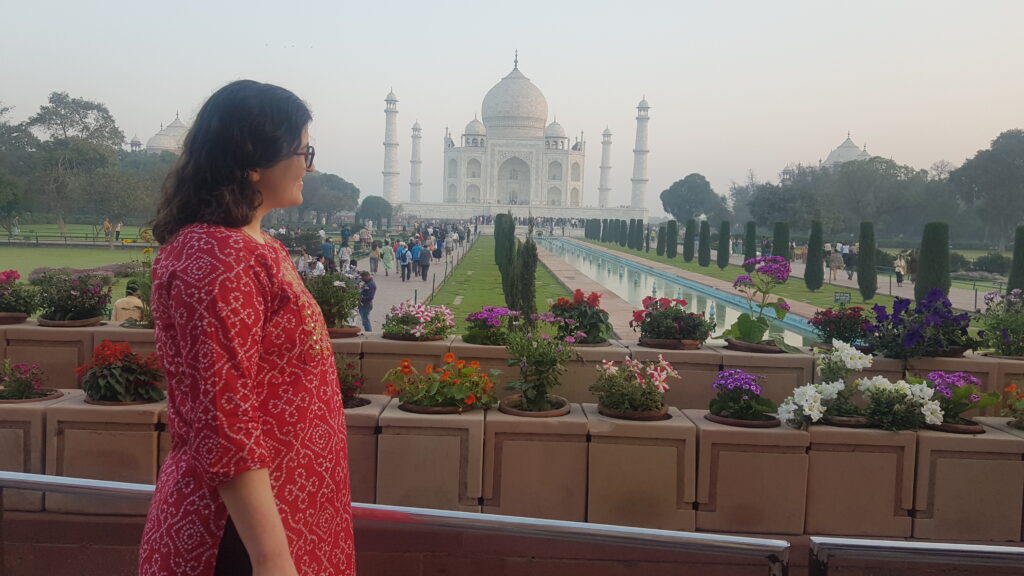Visiting the North of India
Guest Post By: Ellen Schneider, a Full-Time MBA Candidate. She is a Global Business Center Study Abroad Scholarship Recipient, and she studied abroad through I BUS 579: Global Consulting Project – India during Spring Break 2024.
I love traveling and have had the opportunity to live and travel abroad, but this was my first visit to India. We arrived in the middle of the night at our hotel in New Delhi. We slept for a few hours then started our sightseeing.
 The first place we visited was Gurdwara Bangla Sahib, a Sikh temple. We had a guide show us around the temple and teach us about the Sikh religion. We removed our shoes, covered our heads, and walked through cleansing water on the outskirts of the temple. The temple was gorgeous, as were the grounds. We went to the temple’s cafeteria to learn about the tradition of langar, where workers and volunteers make food all day long for anyone of any faith to join them in a meal. The room filled with people waiting from outside. Everyone got food to eat and sat on the floor to enjoy their meal. Once everyone was done, the room filled back up with another huge group of people. They feed tens of thousands of people every day. We walked through the kitchen to see how the operation worked, and I was astonished by the amount of food they went through.
The first place we visited was Gurdwara Bangla Sahib, a Sikh temple. We had a guide show us around the temple and teach us about the Sikh religion. We removed our shoes, covered our heads, and walked through cleansing water on the outskirts of the temple. The temple was gorgeous, as were the grounds. We went to the temple’s cafeteria to learn about the tradition of langar, where workers and volunteers make food all day long for anyone of any faith to join them in a meal. The room filled with people waiting from outside. Everyone got food to eat and sat on the floor to enjoy their meal. Once everyone was done, the room filled back up with another huge group of people. They feed tens of thousands of people every day. We walked through the kitchen to see how the operation worked, and I was astonished by the amount of food they went through.
The next day we went to Qutb Minar. It is a very famous minaret built in the 12th and 13th centuries. Part of the complex was built using the torn-down materials of Hindu temples that were there before. We could see the various deities still on the walls with their faces removed. We observed there would have been something eco-conscious about it if it hadn’t been so troubling.
Then we went to Old Delhi, and I was astounded by the crowds of people and vehicles that filled the streets. We rode bicycle rickshaws for fun to a spice market and bought too many spices and teas to bring home.
Then we visited Swaminarayan Akshardham, a Hindu temple. We weren’t allowed to bring our cameras or phones inside. It was built by hand in just about 5 years. It’s made entirely of pink sandstone and Italian Carrera marble. The work inside is incredibly detailed, bright, and hand carved. It opened in 2005, and it’s amazing to think about the effort it took to hand-carve an entire temple instead of using machines in the modern era.
We left Delhi and took our bus to Agra. We happened upon a wedding at the hotel we were staying at in Agra. We woke up extremely early the next morning to see the Taj Mahal at sunrise, which is reputed to be the most beautiful time to see it. On the way, we saw monkeys playing in the outer gardens of the complex and were ushered away by our guide so we wouldn’t miss the sunrise. We made it to the entrance just in time for the incredibly beautiful moment. The Taj Mahal looks unbelievably exactly the way it does in pictures. From far away it looked like a painting. As we got closer, we were able to notice more and more of the details, such as the reflections in the water outside, the carved flowers and other motifs, and the shining stone inlays in the sunlight. I learned that the entire complex is symmetrical except for one thing: the king’s tomb is laid to one side so he could join the queen after death.

Later that day, we drove to Jaipur, which was my favorite city we visited in India. We visited the Amber Fort. We drove by and saw the Hawa Mahal and Jal Mahal. We had lunch at Samode Haveli hotel, which was super fancy and beautiful. Then we went to the observatory. We went to a textile factory and saw block printing and carpet making. There was so much more to see but not enough time to see it all.
The next day, we flew to Ahmedabad for the work to begin! Meeting and working with the SEWA sisters was incredibly rewarding and humbling. We spent the next few days travelling to meet clusters of women farmers outside the city and learning about what they needed to continue and improve their work. We collaborated with representatives from the Ahmedabad SEWA office to come up with a strategy for creating business plans for two different clusters of farmers we had met. We left Ahmedabad with a long to-do list and motivation to do our best work!

